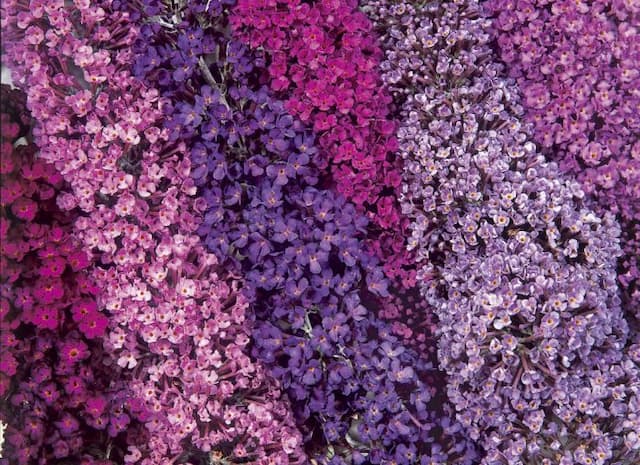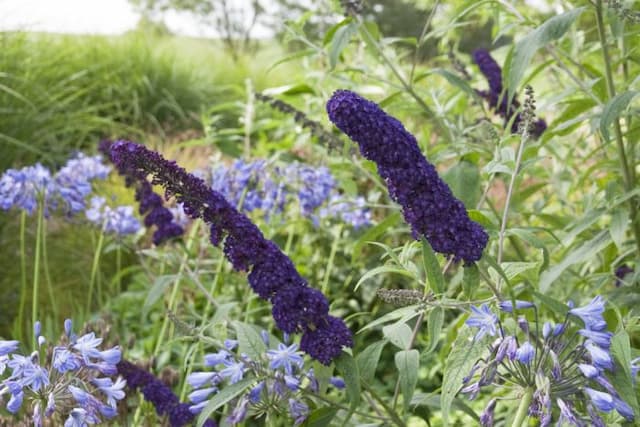Buddleja 'Lochinch'

ABOUT
The Buddleja 'Lochinch', commonly known as the Butterfly Bush, is notable for its attractive floral display and foliage. The plant bears conical clusters of small, star-shaped flowers that grace the tips of its arching stems. These blossoms are usually a mesmerizing lavender-blue, featuring orange eyes in the center that add to their beauty and intricacy. The Butterfly Bush's flowers are famous for their sweet scent, which often fills the air around the plant, drawing numerous butterflies and bees, hence its common name. The leaves of the Butterfly Bush are another of its appealing characteristics. They are a silvery-green color, soft to the touch, typically with a fine, downy texture. The shape of the leaves is lanceolate, meaning they are shaped like a lance tip, tapering towards the end and generally a bit wider in the middle. Overall, the Butterfly Bush has a graceful and relaxed habit, with an arching growth that lends a casual elegance to gardens and landscapes where it is planted. With its delightful blossoms and appealing foliage, the Buddleja 'Lochinch' is a favorite among garden enthusiasts for adding a splash of color and a magnet for pollinators.
About this plant
 Names
NamesFamily
Scrophulariaceae
Synonyms
Butterfly Bush, Summer Lilac
Common names
Buddleja 'Lochinch'
 Toxicity
ToxicityTo humans
Butterfly bush, including the Buddleja 'Lochinch' variety, is not typically considered toxic to humans. There are no well-documented cases of poisoning from ingesting parts of this plant. It is always wise, however, to exercise caution and avoid consuming plant materials that are not known to be edible, as individual sensitivities can vary.
To pets
Butterfly bush is generally not regarded as toxic to pets such as dogs and cats. There is no significant evidence to suggest that Buddleja 'Lochinch' causes poisoning in animals if they happen to ingest parts of the plant. Though non-toxic, it's still a good practice to prevent pets from consuming plants not intended for their diet to avoid potential gastrointestinal upset or other individual sensitivities.
 Characteristics
CharacteristicsLife cycle
Perennials
Foliage type
Semi-deciduous
Color of leaves
Gray-green
Flower color
Lavender-blue
Height
6-8 feet (1.8-2.4 meters)
Spread
4-6 feet (1.2-1.8 meters)
Plant type
Shrub
Hardiness zones
5-9
Native area
Cultivar
Benefits
 General Benefits
General Benefits- Attracts Wildlife: The Buddleja 'Lochinch' is known for attracting butterflies and bees, beneficial for pollination.
- Low Maintenance: It is a hardy plant that requires minimal care once established, making it suitable for gardeners of all skill levels.
- Drought Tolerant: Once established, it can tolerate periods of dry weather, reducing the need for constant watering.
- Fast Growth: This plant grows relatively quickly, which can provide a mature look in the garden in a shorter amount of time.
- Decorative Flowers: The plant boasts attractive lavender-blue flowers that can add a splash of color to a garden.
- Fragrance: The flowers emit a sweet, honey-like fragrance which can enhance the sensory appeal of a garden space.
- Long Blooming Period: Buddleja 'Lochinch' has a long flowering season, typically from mid-summer to autumn, providing extended interest in the garden.
- Easy to Propagate: It is easy to propagate from cuttings, meaning gardeners can create new plants for free.
- Versatility: Suitable for a variety of garden styles, including borders, cottage gardens, and wildlife gardens.
- Seasonal Interest: In addition to flowers, some Buddleja 'Lochinch' varieties offer interesting foliage or seed heads that contribute to the garden's winter interest.
- Privacy: When planted in groups or rows, it can create a natural screen, offering privacy and reducing noise from outside sources.
 Medical Properties
Medical PropertiesThis plant is not used for medical purposes.
 Air-purifying Qualities
Air-purifying QualitiesThis plant is not specifically known for air purifying qualities.
 Other Uses
Other Uses- Buddleja 'Lochinch', commonly known as Butterfly Bush, can be used in textile dyeing, providing natural colors from its flowers.
- It is also useful in crafts, with its dried flower spikes being incorporated into potpourri mixtures for a pleasant fragrance.
- The Butterfly Bush can serve as a natural means of attracting pollinators to vegetable gardens, thus aiding in the pollination of crops.
- Its branches may be used in basketry, woven while they are still green and flexible for creating garden ornaments.
- The wood from Buddleja 'Lochinch' can be used for creating garden stakes or markers due to its straight growth habit.
- The leaves and flowers can be used to create a natural, light-sensitive paper for sun printing, capturing silhouettes of objects placed on top.
- In woodworking projects, the smaller branches can be utilized as decorative inlays for a rustic touch.
- Butterfly Bush sap can be used as a natural adhesive in certain traditional crafts, although it's not as strong as commercial glues.
- The Butterfly Bush's dense foliage makes it ideal for creating garden mazes or privacy screens.
- Lastly, the plant’s flowers can be used as a flavoring agent in homemade syrups or ice creams for a subtle floral note.
Interesting Facts
 Feng Shui
Feng ShuiButterfly Bush is not used in Feng Shui practice.
 Zodiac Sign Compitability
Zodiac Sign CompitabilityButterfly Bush is not used in astrology practice.
 Plant Symbolism
Plant Symbolism- Transformation – The Buddleja, commonly known as the Butterfly Bush, symbolizes transformation due to its ability to attract butterflies, which are widely seen as a symbol for change and metamorphosis.
- Attraction – Its sweet fragrance and vibrant flowers are known to attract pollinators, symbolizing allure and magnetism.
- New Beginnings – Butterfly Bush is often associated with new beginnings, as it draws in the creatures that undergo profound changes and new stages of life.
- Hope – Buddleja's capacity to proliferate even in tough conditions makes it a symbol of hope and perseverance.
 Water
WaterThe Butterfly Bush (Buddleja 'Lochinch') should be watered deeply once a week, providing about 1 gallon of water for each plant. During hot, dry periods, increase watering frequency to twice per week. Ensure that the soil is moist but not waterlogged. It's best to water the plant early in the morning to allow the foliage to dry before evening. Overwatering can lead to root rot, so adjust your watering schedule according to the weather and soil conditions.
 Light
LightButterfly Bush thrives in full sun, meaning it requires at least 6 to 8 hours of direct sunlight daily. The best spot for it is an open area with unobstructed exposure to sunlight. While it can tolerate some light shade, its flowering might be reduced in less than optimal light conditions.
 Temperature
TemperatureThe Butterfly Bush prefers temperatures ranging from 60°F to 90°F and can handle temperatures as low as 20°F without significant damage. Ideally, maintain a warm environment for optimal growth and flowering. Sudden frost can damage the plant, but established plants are generally hardy in cooler temperatures.
 Pruning
PruningPrune the Butterfly Bush in late winter or early spring before new growth starts. This encourages bushier growth and more abundant flowers. Remove dead and weakened stems, and cut back the remaining stems to about one foot above the ground. Pruning annually is essential to maintain plant vigor and shape.
 Cleaning
CleaningAs needed
 Soil
SoilButterfly Bush (Buddleja 'Lochinch') thrives in well-drained soil with a pH ranging from slightly acidic to neutral (pH 6.0 to 7.0). The ideal soil mix should consist of garden soil, compost, and coarse sand or perlite to ensure good drainage. Amending the soil with organic matter will also help to provide the necessary nutrients for growth.
 Repotting
RepottingButterfly Bush (Buddleja 'Lochinch') typically does not require frequent repotting as it is often grown as a shrub in the garden. If potted, repotting every 2 to 3 years or when the plant becomes root-bound should suffice.
 Humidity & Misting
Humidity & MistingButterfly Bush (Buddleja 'Lochinch') is tolerant of a wide range of humidity levels and generally does not require any special humidity considerations as it is adaptable to outdoor conditions where it naturally thrives.
 Suitable locations
Suitable locationsIndoor
Place Butterfly Bush in bright light, avoid overwatering, and ensure good air circulation.
Outdoor
Plant in full sun, use well-draining soil, water regularly, and shelter from strong winds.
Hardiness zone
5-9 USDA
 Life cycle
Life cycleThe life of the Butterfly Bush 'Lochinch' begins with seed germination, which occurs when conditions are warm and moist. Following germination, the seedling stage is marked by the emergence of the first set of true leaves, and the plant gradually matures. Growth continues into a vegetative state where the 'Lochinch' develops its characteristic grey-green foliage and an extensively branching habit. As it enters the flowering stage, usually in mid to late summer, it produces fragrant flowers that attract numerous pollinators. After pollination, flowers may produce small seeds that disperse, leading to the potential growth of new plants. The Butterfly Bush 'Lochinch' is a perennial, experiencing dieback in colder climates during the winter months and regrowth from the roots in the spring.
 Propogation
PropogationPropogation time
Spring-Early Summer
The most popular method of propagation for the Butterfly Bush 'Lochinch' is through semi-hardwood cuttings. Typically, this is done in summer when the plant has new growth that is beginning to mature but isn't yet fully hardened. A gardener would take cuttings of about 6 inches (approximately 15 centimeters) in length, ensuring there are several nodes on each cutting. It's essential to make a clean cut just below a node and remove the lower leaves. The cut end is often dipped into a rooting hormone powder to encourage root development and then placed into a potting mixture of peat and perlite or sharp sand. These cuttings are then kept in a well-lit area, out of direct sunlight, and maintained in moist conditions by covering with a plastic bag or placing in a cold frame until roots have developed. After rooting, which may take a few weeks to a couple of months, the new plants can be transplanted into individual pots or into the garden.


![Butterfly bush [Adonis Blue]](/_next/image?url=https%3A%2F%2Fplants-admin.emdemapps.com%2Fimages%2Fplants%2F%2Fimages%2F604b56e58f983.png&w=640&q=75)


![Butterfly bush [Buzz Ivory]](/_next/image?url=https%3A%2F%2Fplants-admin.emdemapps.com%2Fimages%2Fplants%2F%2Fimages%2F604b57987dfa8.png&w=640&q=75)
![Butterfly bush [Camberwell Beauty]](/_next/image?url=https%3A%2F%2Fplants-admin.emdemapps.com%2Fimages%2Fplants%2F%2Fimages%2F604b5ead04c12.png&w=640&q=75)


